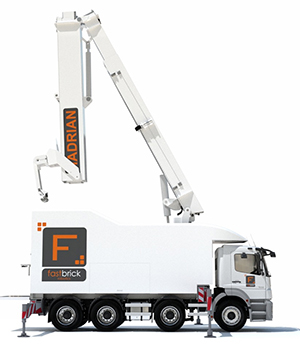Australian firm Fastbrick Robotics has developed a machine capable of laying roughly 1,000 bricks an hour, equivalent to the entire shell of a house in just two days. With commercial launch scheduled for late 2017, BIM+ spoke to the company’s communications coordinator, Oliver Gray, about the potential market and whether human workers should be worried about their jobs.
How does the Hadrian X bricklaying robot work?
The machine resembles a regular truck, with a 30m telescopic arm mounted on the back that places bricks with precision accuracy using a laser guidance system.
The robot can be loaded with different brick sizes, or cut, grind, and mill bricks inside the trailer, to fit the structure before placement. Bricks are moved from a pack in the trailer and placed onto a “shuttle” that transports them either to the saw for cutting, a router for drilling, or a transfer robot, for laying.
Bricks ready to be laid move through a conveyor belt system within the boom arm of the robot and are placed by a laying head, guided using a laser tracker and a smart track sensor.
Is the technology already proven?
The Hadrian X model is a larger and faster version of the 105 prototype model, first demonstrated in summer 2016, which had a 28m boom and was capable of laying 225 bricks per hour.
How much will the new version cost?
The Hadrian X will be available towards the end of this year, with a price tag of approximately A$2m (£1.25m).

The machine doesn’t appear to use mortar, how does it bind bricks together to create a solid load-bearing structure?
Rather than using traditional mortar, the Hadrian X uses a specialised industrial adhesive that is five times stronger than mortar, offers up to 70% greater insulation, and has a much faster drying time. This adhesive is applied by the machine prior to the placement of the brick. In addition, the interlocking precision bricks used are 15 times larger than standard bricks.
Does the machine run using conventional 3D design software used in construction?
Our standalone TAD proprietary software was initially designed to handle production and laying data for the Hadrian 105. It has now evolved into an architectural design tool with many unique functions. A version to begin field trials this year will enable builders to design, tender work, assign contractors, purchase components and invoice for payment, all via a PC, smartphone or tablet.
What is the potential market for the robot?
We estimate a global addressable market of A$100 to A$200bn (figures from BDO Consulting). The most attractive markets are Australia, Canada, the US and the UK, with a total addressable market of A$12bn.
It is difficult to predict how the global market will change over the next decade, but with the number of people inhabiting the earth increasing exponentially, the need for human dwellings and other constructions will surely be on the rise.
Will the technology eradicate the need for human bricklayers?
Our bricklaying machine is sure to displace a lot of human workers in the industry, just the same as other innovations will replace workers in other industries – it is simply the way of the future. We hope, however, that bricklayers will be able to move from their current labour-intensive roles to a more supervisory “quality assurance” role while operating the Hadrian X.
Our innovation has been widely viewed as having a negative impact on the bricklaying industry, but it in fact has the potential to be an immensely positive change by greatly improving the quality of working conditions and removing the often dangerous circumstances bricklayers have to work in.
Our bricklaying machine is sure to displace a lot of human workers in the industry, just the same as other innovations will replace workers in other industries – it is simply the way of the future.– Oliver Gray, Fastbrick Robotics
Comments
Comments are closed.












Where is the stop point for putting people out of work going to stop? There is something incredibly wrong here, when machines are more important that providing a livelihood for the workforce.
At a cost of A$2 Million for the machine it will need to build a lot of houses to be cost effective. What is the return on investment? It does not seem cost efficient unless the price drops dramatically.